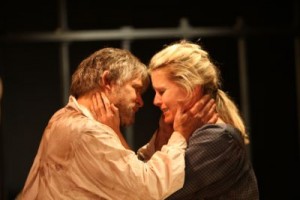NOT RECOMMENDED
Arthur Miller’s The Crucible holds a special place in my heart. It gave me my very first experience as a stage actor at the age of 16, and though I later watched the 1996 film on video, it wasn’t until December 2007 that I saw The Crucible staged for the very first time, decades after high school, in a production that left me devastated, as the playwright certainly intended.
Miller’s tale of the 1692 Salem Witch Trials was written in response to the Communist Witch Hunt led by Senator Joe McCarthy in the early 1950s, and it resonates every bit as strongly in 2009—as a warning of the dangers of mixing religious zealotry and ignorance. When John Proctor asks Reverend Parris “Can you speak one minute without we land in Hell again?”, his words could just as easily be directed at a 21st Century religious fundamentalist. Giles Corey’s fear of his wife’s nightly reading reflects the same mistrust of intellect and education that has kept many a Virginia Foxx and Sally Kern in political office. 1692 Salem was a “believe-as-we-do-or-else” society where reason and logic were thrown to the wind—and not too much different from what can be heard on certain TV channels today.
That being said, I was understandably excited about seeing The Crucible again, especially as an Actor’s Co-op production. The Co-op has a track record as one of L.A.’s most consistently outstanding intimate theater companies, and rarely have I been unable to recommend a Co-op production. Unfortunately, this is one of those very few times.
That is not to say that the Co-op’s The Crucible isn’t filled with some magnificent performances. It is, beginning with a pair of absolutely stunning ones given by two of the large cast’s supporting actors.
As teen seductress Abigail Williams, Nicole Gabriella Scipione does the kind of work that makes me wonder—Why haven’t I heard of her before? and When can I see her again? Scipione is a positively electric stage presence, tall, slender, stunning, with eyes that burn with emotion, whether with lust for another woman’s husband or rage at being spurned or in feigned terror at the witch trials. Remember Glenn Close in Fatal Attraction? Scipione is that woman, minus a couple decades. She is an actress you simply can’t take your eyes off of—with many great roles ahead of her.
Making an equally strong impression is Daniel J. Roberts in the role I played at 16, Abigail’s uncle the Reverend Parris. Roberts is younger than the role is usually cast (though not as young as I was) but it makes sense, as his daughter Betty is only 10. To look at Roberts, you’d think “romantic lead,” which makes his character role here even more striking. Roberts captures all the frenzy of a contemporary televangelist, his eyes every bit as ablaze as Abby’s, as well as the persistent fear of being found out as a fraud. In Parris’ final scenes as a broken man, Roberts is downright devastating.
Co-op regulars are so used to seeing Bruce Ladd in flamboyant roles that his understated yet commanding work as John Proctor may come as a surprise, and it is a pleasure to see the lovely Nan McNamara (Elizabeth Proctor) back on stage at the Co-op for the first time in several years, bringing an inner fire to the outwardly serene “Goody” Proctor.
Gary Clemmer’s nice guy persona, which made his work in The Nibroc Trilogy so unforgettable, serves him well in his portrayal of Reverend John Hale, whose arrival in Salem proves a catalyst for the accusations of witchcraft which follow. Clemmer is so innately sympathetic that we see his belief in Satan’s disciples as more reasonable than it might be in another actor, and his ultimate rejection of the trials as all the more significant.
Director Marianne Savell understands Miller’s message, stages scenes imaginatively making full use of the Crossley’s thrust stage, and has guided her actors to some thrilling performances.
My problem with the Co-op’s production of The Crucible rests with the remaining lead character, Deputy Governor Thomas Danforth, judge at the Salem Witch Trials. Casting award-winning actor Eddie Hailey in the role is an example of what is known as “non-traditional casting,” and in this instance, for me at least, it proves a critical misstep.
Let it be clear, I am an advocate of non-traditional casting. I believe that directors and casting directors are all too often guilty of not thinking “outside the box.” Many of the shows reviewed here with mostly Caucasian casts could just as easily have featured Asian, Latino, African American, or other minority actors in major roles to powerful effect. This is precisely what the Co-op did in their 2001 production of Wait Until Dark, which featured the marvelous African American actress Lisa Renee Pitts in the lead role of Susy. Bravo to the Co-op! More productions should be doing likewise.
Even when not historically accurate, non-traditional casting can work, especially in musicals where an extra measure of suspension of disbelief is already required—after all, people don’t normally burst into song and dance. It can also work too when “colorblind casting” is across the board, the acting ensemble made up of a rainbow racial/ethnic mix—which is not the case in the Co-op’s production of The Crucible.
Where non-traditional casting doesn’t work—at least for this reviewer—is when it denies historical fact, especially in a play like The Crucible in which race does play a part. The character of Tituba is a black slave, from Barbados. She is played in this production by an African American actress (the excellent Andréa Kim Walker), whose race was surely a factor in casting. We are expected to notice that the actress is black and she is referred to as such. At the same time, and in the same production, we are expected to view with colorblind eyes an African American actor in the role of the Deputy Governor of 1692 Massachusetts. I was not able to. A black man in a position of power in 17th Century colonial America is historically inaccurate. It distorts history in a play which is about history. For this reviewer at least, it made suspension of disbelief an impossibility in the second act.
The rest of the cast is a fine one indeed, beginning with Abby’s four hench-girls: Chloe Babbes as Betty Parris, Teresa Bisson as Mercy Lewis, Tannis Hanson as Mary Warren, and Laura Manchester as Susanna Walcott. The excellent Bisson also doubles effectively as Sarah Good, and Hanson as Mary is the perfect melding of actress and role, allowing Hanson to show range which her charming work as Milky White in Into The Woods didn’t quite give her the chance to display. Completing the uniformly strong ensemble are Gus Corrado as Giles Corey, Tim Farmer as Francis Nurse, E. Merlin Froyd as Marshal Herrick, Steve Gustafson as Thomas Putnam, Rebecca Hayes as Mrs. Ann Putnam, Diane Sainte-Marie as Rebecca Nurse, David Scales as Judge Hathorne, and understudy Richard Soto as Ezekiel Cheever.
Gary Lee Reed’s wood-paneled set design makes excellent use of the thrust stage, and transforms into four different locations, most stunningly into the last scene’s Salem jail cell. Shon LeBlanc’s costumes, James L. Moody’s lighting, Joseph King Barkley’s original music, Lori Berg’s props, and Rick Marcus’ fight choreography all contribute to a good-looking and sounding production.
I realize that there are those who will say that I am wrong to complain about the casting of Danforth, as well as those who will have absolutely no problem with it and won’t even see what the fuss is about. For this reviewer at least, it took me out of the play and even The Crucible’s emotional climax failed to get me back in.
Actors Co-op, 1760 N. Gower St., Hollywood.
www.actorsco-op.org
–Steven Stanley
May 3, 2009
Photos: Lindsay Schnebly




 Since 2007, Steven Stanley's StageSceneLA.com has spotlighted the best in Southern California theater via reviews, interviews, and its annual StageSceneLA Scenies.
Since 2007, Steven Stanley's StageSceneLA.com has spotlighted the best in Southern California theater via reviews, interviews, and its annual StageSceneLA Scenies.







 COPYRIGHT 2025 STEVEN STANLEY :: DESIGN BY
COPYRIGHT 2025 STEVEN STANLEY :: DESIGN BY